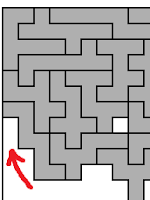(Part 1 is here, I'd recommend reading it first.)
After making the heptomino constructions in the above post, octominoes seemed like the logical next step. And we are spoiled for choice when it comes to which size squares we can make from them.
Firstly for solid squares with no centre hole, n² for when n is a multiple of 4, so we can construct 4x4, 8x8, 12x12 and so on. Great stuff. But it gets even better..! Through some happy coincidence of mathematics it turns out that for all odd n, n²-1 is divisible by 8. This means we can fill any odd edge-length square with octominoes as long as we give it a one-cell central hole. In fact, the only sizes we can't theoretically do are the squares with edge lengths even but not a multiple of 4: 2x2, 6x6, 10x10 etc. (Oh, and really tiny squares like 1x1 which are too small to do anything with. I guess in a strange way, the 1x1 square is just zero octominoes around a central hole so it sort of counts, but it's a weird edge case.)
Next step - pick a bunch of these squares whose total area is 2952. There are many ways of doing this; I picked one that included as many different sizes of square as possible. One of each possible size from 3x3 all the way up to 21x21, and then a second 12x12 and 13x13 in order to make the numbers work.
 |
| The 3x3 was easy enough to solve, but it was all downhill from there... |
This took all afternoon and long into the evening to solve by hand. Early on the most challenging part was digging through the box of octominoes to find the specific bit I needed - my set are made of fluorescent acrylic so I can shine a UV torch into the box to make the edges stand out a bit better, but it's still infuriating digging through three-hundred-and-odd near identical pieces looking for a specific one. Especially when it turns out the piece I'm after has already been used up.
But by the time I was down to the last three squares (the three largest; I did them in ascending size order because doing one of the tiny ones last just sounded utterly horrifying) I was faced with a different problem. The thing with solving lots of separate squares is that there's lots of edges - way more than just solving one large rectangle. And the boundary between solution and empty space demands a higher proportion of straight-edged pieces. And pieces capable of filling 2, 3 and 4 cell deep indentations right at the edge of the construction.
 |
| Stuff like this. |
Early on this wasn't much of a problem, but the further I progressed the less pieces I had remaining capable of plugging a hole like this. On the very last square I totally ran out and had to just build really carefully so as to not create a hole like this at the edge. And I managed - just.
The other tough bit was each time I finished off a square. Even with all the forward planning in the world, you don't seem to get a lot of say in what the space left for the last 2 or 3 pieces in a square looks like. And although sometimes you can partition it up without using an already-used piece or a nice piece with a 2x2 block in it, most times you've just got to take one for the team and sacrifice a potentially useful late game piece. It hurts, but there's no other way. And with octominoes, there's so many pieces with 2x2 blocks you can afford to use up one or two (or ten) prematurely along the way. Having to spend the big P-shaped piece in the top-right of the 19x19 square though... that wasn't fun.
So yeah, other related challenges. For the reader of course, because on completing this I swore off touching another octomino for at least a week.
- My construction is 17 squares total. Can anyone improve on that? (As in: more, smaller squares.)
- My construction has 15 distinct sizes of square. Is there a way to increase that, to take those duplicated 12x12 and 13x13 squares and somehow use that area to introduce another variety in there?
Do the ones with 9-15 cells next!
ReplyDelete